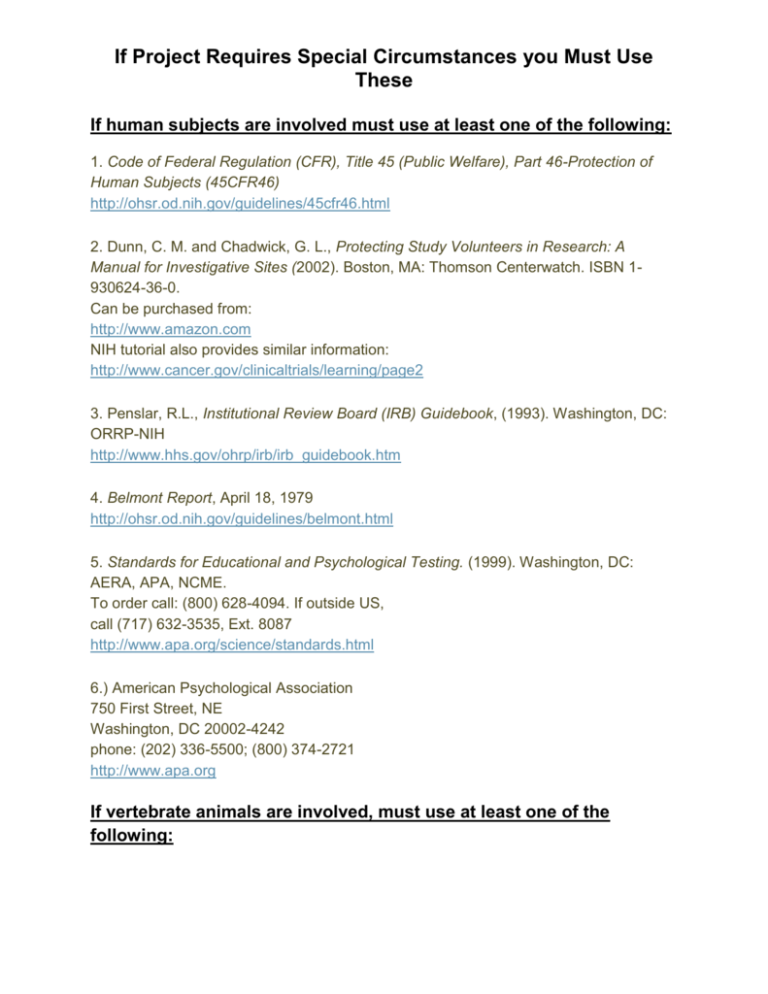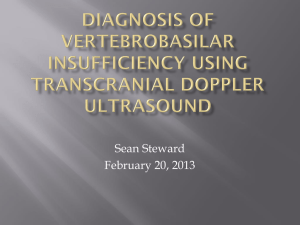Doc. - Science Fair
advertisement

If Project Requires Special Circumstances you Must Use These If human subjects are involved must use at least one of the following: 1. Code of Federal Regulation (CFR), Title 45 (Public Welfare), Part 46-Protection of Human Subjects (45CFR46) http://ohsr.od.nih.gov/guidelines/45cfr46.html 2. Dunn, C. M. and Chadwick, G. L., Protecting Study Volunteers in Research: A Manual for Investigative Sites (2002). Boston, MA: Thomson Centerwatch. ISBN 1930624-36-0. Can be purchased from: http://www.amazon.com NIH tutorial also provides similar information: http://www.cancer.gov/clinicaltrials/learning/page2 3. Penslar, R.L., Institutional Review Board (IRB) Guidebook, (1993). Washington, DC: ORRP-NIH http://www.hhs.gov/ohrp/irb/irb_guidebook.htm 4. Belmont Report, April 18, 1979 http://ohsr.od.nih.gov/guidelines/belmont.html 5. Standards for Educational and Psychological Testing. (1999). Washington, DC: AERA, APA, NCME. To order call: (800) 628-4094. If outside US, call (717) 632-3535, Ext. 8087 http://www.apa.org/science/standards.html 6.) American Psychological Association 750 First Street, NE Washington, DC 20002-4242 phone: (202) 336-5500; (800) 374-2721 http://www.apa.org If vertebrate animals are involved, must use at least one of the following: If Project Requires Special Circumstances you Must Use These 1. Guide for the Care and Use of Laboratory Animals, Institute of Laboratory Animal Research (ILAR), Commission on Life Sciences, National Research http://dels.nas.edu/ilar_n/ilarhome/reports.shtml 2. Principles and Guidelines for the Use of Animals in Precollege Education (a free pamphlet from ILAR) Can be found online: http://dels.nas.edu/ilar_n/ilarhome/reports.shtml 3. Guidelines for the Care and Use of Mammals in Neuroscience and Behavioral Research (2003), Institute for Laboratory Animal Research (ILAR). To order these ILAR publications contact: National Academies Press 500 Fifth Street, NW Lockbox 285 Washington, DC 20055 phone: (888) 624-8373 or (202) 334-3313 fax: (202) 334-2451; http://www.nap.edu 4. Federal Animal Welfare Act (AWA) 7 U.S.C. 2131-2157 Subchapter A—Animal Welfare (Parts I, II, III) http://www.nal.usda.gov/awic/legislat/awicregs.htm Above document is available from: USDA/APHIS/AC 4700 River Road, Unit 84 Riverdale, MD 20737-1234 email: ace@aphis.usda.gov Tel: (301) 734-7833 Fax: (301) 734-4978 http://awic.nal.usda.gov 5. Guide for the Care and Use of Agricultural Animals in Agricultural Research and Teaching (Agri-Guide) Federation of Animal Science Societies (FASS) 1111 N. Dunlap Avenue Savoy, IL 61874 phone: (217) 356-3182 If Project Requires Special Circumstances you Must Use These email: fass@assochq.org http://www.fass.org 6. Guidelines for the Use of Fish in Research (2004), American Fisheries Society. http://www.fisheries.org/afs/publicpolicy.html 7. Euthanasia Guidelines AVMA Guidelines on Euthanasia (June 2007) American Veterinary Medical Association. http://www.avma.org/issues/animal_welfare/euthanasia.pdf Sources of Information for Alternative Research and Animal Welfare 1. The National Library of Medicine provides computer searches through MEDLINE: Reference & Customer Services National Library of Medicine 8600 Rockville Pike Bethesda, MD 20894 (888) FIND-NLM or (888) 346-3656 (301) 594-5983; email: custserv@nlm.nih.gov http://www.nlm.nih.gov http://www.ncbi.nlm.nih.gov/entrez/query.fcgi 2. National Agriculture Library (NAL) provides reference service for materials that document a) Alternative Procedures to Animal Use and b) Animal Welfare. Animal Welfare Information Center National Agriculture Library 10301 Baltimore Avenue, Room 410 Beltsville, MD 20705-2351 phone: (301) 504-6212, fax: (301) 504-7125 email: awic@nal.usda.gov http://www.nal.usda.gov/awic 3. Institute of Laboratory Animal Resources (ILAR) provides a variety of information on animal sources, housing and handling standards, and alternatives to animal use through annotated bibliographies published quarterly in ILAR Journal. ILAR The Keck Center of the National Academies If Project Requires Special Circumstances you Must Use These 500 Fifth Street, NW, Keck 687 Washington, DC 20001 phone: (202) 334-2590, fax: 202-334-1687 email: ILAR@nas.edu http://dels.nas.edu/ilar/ 4. Quarterly bibliographies of Alternatives to the Use of Live Vertebrates in Biomedical Research and Testing may be obtained from: Specialized Information Services NLM/NIH 2 Democracy Plaza, Suite 510 6707 Democracy Blvd., MSC 5467 Bethesda, MD 20892-5467 phone: (301) 496-1131; Fax: (301) 480-3537 Toll Free: (888) FIND NLM or (888) 346-3656 Email: tehip@teh.nlm.nih.gov http://www.sis.nlm.nih.gov ; http://toxnet.nlm.nih.gov/altbib.html 5. John’s Hopkins Center for Alternatives to Animal Testing (CAAT) has worked with scientists since 1981 to find new methods to replace the use of laboratory animals in experiments, reduce the number of animals tested, and refine necessary tests to eliminate pain and distress. email: caat@jhsph.edu http://caat.jhsph.edu/ If potentially hazardous biological agents (PHBA) are involved, must use at least one of the following: American Biological Safety Association: ABSA Risk Group Classification – list of organisms http://www.absa.org American Type Culture Collection (703) 365-2700; (800) 638-6597 (US, Canada, & PR) http://www.atcc.org If Project Requires Special Circumstances you Must Use These Bergey’s Manual of Systematic Bacteriology website – follow the links for resources and microbial databases for a collection of international websites of microorganisms and cell cultures: http://www.bergeys.org Biosafety in Microbiological and Biomedical Laboratories (BMBL)—4th Edition. Published by CDC-NIH, To order: Office of Health and Safety Centers for Disease Control and Prevention 1600 Clifton Road, NE, Mailstop F05 Atlanta, GA 30333 http://www.cdc.gov/od/ohs/biosfty/biosfty.htm World Health Organization Laboratory Safety Manual-3rd Edition http://www.who.int/csr/bioriskreduction/ Available online in English, French, Spanish, & Portuguese. Provides practical guidance on biosafety techniques for use in laboratories at all levels. Includes risk assessment and safe use of recombinant DNA technology, and provides guidelines for the commissioning and certification of laboratories. If hazardous chemicals, activities or devices are involved, must use at least one of the following: General Lab/Chemical Safety Safety in Academic Chemistry Laboratories, Volumes 1 and 2, 2003. Washington, DC: American Chemical Society. Order from (first copy free of charge): American Chemical Society Publications Support Services 1155 16th Street, NW Washington, DC 20036 phone: (202) 872-4554 or 1-800-227-5558 email: pss@acs.org, website: http://www.acs.org/publications Safety in the Research Laboratory A free DVD from Howard Hughes Medical Institute that includes sections on If Project Requires Special Circumstances you Must Use These working with cell cultures, radioactive materials and other laboratory materials. Other free safety DVD’s are also available: order from the website: http://catalog.hhmi.org/index.jsp Environmental Protection Agency (EPA) website for green chemistry: http://www.epa.gov/greenchemistry Material Safety and Data Sheets (MSDS) MSDS should be collected by your laboratory or available from the manufacturer. The internet also has a range of free resources: http://www.flinnsci.com/sections/safety/safety.asp - A directory of MSDS sheets from Flinn Scientific Inc. that includes a ranking of hazard level and disposal methods http://www.ilpi.com/msds/index.html - A listing of numerous sites that have free downloads of MSDS sheets DEA Controlled Substances Drug Enforcement Agency website: http://www.usdoj.gov/dea Controlled Substance Schedules – a list of controlled substances : http://www.deadiversion.usdoj.gov/schedules/schedules.htm Alcohol, Tobacco Firearms and Explosives Alcohol and Tobacco Tax and Trade Bureau http://www.ttb.gov/ Bureau of Alcohol, Tobacco, Firearms and Explosives http://www.atf.gov Radiation Radiation Studies Information (CDC) http://www.cdc.gov/nceh/radiation/default.htm CDC Laboratory Safety Manuals http://www.cdc.gov/od/ohs/safety/SUPSAFE.PDF http://www.cdc.gov/od/ohs/safety/S2.pdf Occupational Safety and Health Administration Documents available from: OSHA Publications If Project Requires Special Circumstances you Must Use These P.O. Box 37535 Washington, DC 20013-7535 phone: (202) 693-1888; fax: (202) 693-2498 http://www.osha.gov PUB 8-1.7 - Guidelines for Laser Safety and Hazard Assessment STD 1-4.1 - OSHA Coverage of Ionizing Radiation Sources Not Covered by Atomic Energy Act of 1954 U.S. Nuclear Regulatory Commission Material Safety and Inspection Branch One White Flint North 11555 Rockville Pike Rockville, MD 20852-2738 phone: (301) 415-8200; (800) 368-5642 http://www.nrc.gov









